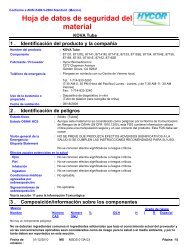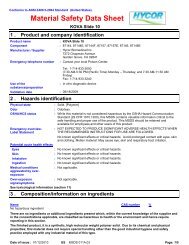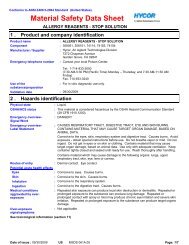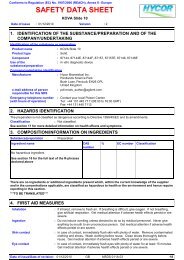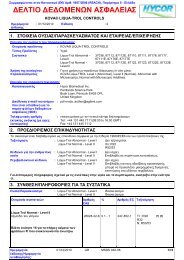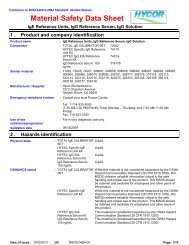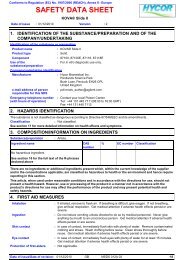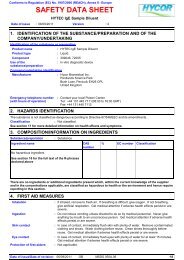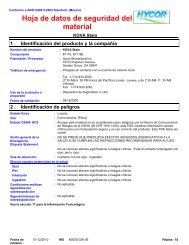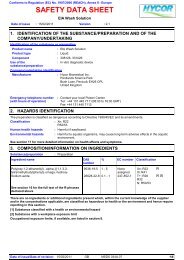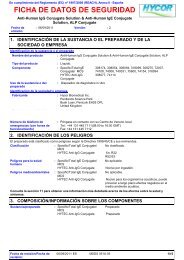SDS EIA Wash Solution_NAEnglish.pdf - Hycor Biomedical
SDS EIA Wash Solution_NAEnglish.pdf - Hycor Biomedical
SDS EIA Wash Solution_NAEnglish.pdf - Hycor Biomedical
Create successful ePaper yourself
Turn your PDF publications into a flip-book with our unique Google optimized e-Paper software.
Conforms to ANSI Z400.5-2004 Standard (United States).<br />
1 .<br />
Material Safety Data Sheet<br />
Product and company identification<br />
Product name<br />
: <strong>EIA</strong> <strong>Wash</strong> <strong>Solution</strong><br />
Component : 308126, 331026<br />
Manufacturer / Supplier : <strong>Hycor</strong> <strong>Biomedical</strong> Inc.<br />
7272 Chapman Avenue<br />
Garden Grove, CA 92841<br />
Emergency telephone number<br />
Use of the<br />
substance/preparation<br />
:<br />
<strong>EIA</strong> <strong>Wash</strong> <strong>Solution</strong><br />
Contact your local Poison Center.<br />
Tel: 1-714-933-3000<br />
(7:30 AM-5:30 PM (Pacific Time) Monday – Thursday; and 7:30 AM-11:30 AM<br />
Friday)<br />
Fax: 714-933-3240<br />
: In vitro diagnostic device<br />
Validation date : 08/24/2009<br />
2 .<br />
Physical state<br />
Hazards identification<br />
OSHA/HCS status<br />
Emergency overview-<br />
Signal Word<br />
Emergency overview-<br />
Label Statement<br />
Potential acute health effects<br />
Eyes<br />
Skin<br />
Inhalation<br />
Ingestion<br />
Medical conditions<br />
aggravated by overexposure<br />
Over-exposure<br />
signs/symptoms<br />
Liquid.<br />
Irritating to eyes.<br />
See toxicological information (section 11)<br />
3 .<br />
:<br />
: This material is considered hazardous by the OSHA Hazard Communication Standard<br />
(29 CFR 1910.1200).<br />
: WARNING !<br />
:<br />
:<br />
:<br />
:<br />
:<br />
:<br />
:<br />
CAUSES EYE IRRITATION. MAY BE HARMFUL IF SWALLOWED. MAY CAUSE<br />
RESPIRATORY TRACT AND SKIN IRRITATION.<br />
May be harmful if swallowed. Irritating to eyes. Slightly irritating to the skin and<br />
respiratory system. Do not ingest. Avoid breathing vapor or mist. Avoid contact with<br />
eyes, skin and clothing. Use only with adequate ventilation. Keep container tightly<br />
closed and sealed until ready for use. <strong>Wash</strong> thoroughly after handling.<br />
Slightly irritating to the skin.<br />
Slightly irritating to the respiratory system. Exposure to decomposition products may<br />
cause a health hazard. Serious effects may be delayed following exposure.<br />
May be harmful if swallowed.<br />
Repeated skin exposure can produce local skin destruction or dermatitis. Repeated or<br />
prolonged exposure to the substance can produce lung damage. Repeated or<br />
prolonged contact with spray or mist may produce chronic eye irritation and severe skin<br />
irritation.<br />
Not applicable.<br />
Composition/information on ingredients<br />
Name CAS number %<br />
Poly(oxy-1,2-ethanediyl), .alpha.-[(1,1,3,3-tetramethylbutyl)phenyl]-.omega.- 9036-19-5 1 - 5<br />
hydroxy-<br />
There are no ingredients or additional ingredients present which, within the current knowledge of the supplier and<br />
in the concentrations applicable, are classified as hazardous to health or the environment and hence require<br />
reporting in this section.<br />
Date of issue : 15/02/2011<br />
US<br />
M<strong>SDS</strong> 034A.07<br />
Page: 1/6
<strong>EIA</strong> <strong>Wash</strong> <strong>Solution</strong><br />
4 .<br />
First aid measures<br />
Eye contact<br />
Skin contact<br />
Inhalation<br />
Ingestion<br />
Protection of first-aiders<br />
Notes to physician<br />
5 .<br />
Fire-fighting measures<br />
Flammability of the product<br />
Products of combustion<br />
Extinguishing media<br />
Suitable :<br />
Not suitable :<br />
Special protective<br />
:<br />
equipment for fire-fighters<br />
:<br />
:<br />
In case of contact, immediately flush eyes with plenty of water for at least 15 minutes.<br />
Get medical attention if adverse health effects persist or are severe.<br />
<strong>Wash</strong> with soap and water. Get medical attention if adverse health effects persist or are<br />
severe.<br />
: If inhaled, remove to fresh air. If not breathing, give artificial respiration. If breathing is<br />
difficult, give oxygen. Get medical attention if adverse health effects persist or are<br />
severe.<br />
: Do not induce vomiting unless directed to do so by medical personnel. Never give<br />
anything by mouth to an unconscious person. Get medical attention if adverse health<br />
effects persist or are severe.<br />
: Not applicable.<br />
: In case of inhalation of decomposition products in a fire, symptoms may be delayed.<br />
The exposed person may need to be kept under medical surveillance for 48 hours.<br />
:<br />
:<br />
Non-flammable.<br />
Decomposition products may include the following materials:<br />
carbon oxides<br />
nitrogen oxides<br />
Use an extinguishing agent suitable for the surrounding fire.<br />
Not applicable.<br />
Fire-fighters should wear appropriate protective equipment and self-contained breathing<br />
apparatus (SCBA) with a full face-piece operated in positive pressure mode.<br />
6 .<br />
Accidental release measures<br />
Personal precautions :<br />
Environmental precautions<br />
Methods for cleaning up<br />
Small spill<br />
7 .<br />
Handling and storage<br />
No action shall be taken involving any personal risk or without suitable training.<br />
Evacuate surrounding areas. Keep unnecessary and unprotected personnel from<br />
entering. Do not touch or walk through spilled material. Avoid breathing vapor or mist.<br />
Provide adequate ventilation. Wear appropriate respirator when ventilation is<br />
inadequate. Put on appropriate personal protective equipment (see section 8).<br />
: Avoid dispersal of spilled material and runoff and contact with soil, waterways, drains<br />
and sewers. Inform the relevant authorities if the product has caused environmental<br />
pollution (sewers, waterways, soil or air).<br />
: Stop leak if without risk. Move containers from spill area. Dilute with water and mop up<br />
if water-soluble or absorb with an inert dry material and place in an appropriate waste<br />
disposal container. Dispose of via a licensed waste disposal contractor.<br />
Handling<br />
Storage<br />
:<br />
:<br />
Do not ingest. Avoid contact with eyes. <strong>Wash</strong> thoroughly after handling.<br />
Store between the following temperatures: 2 to 8°C (35.6 to 46.4°F). Store in<br />
accordance with local regulations. Store in original container protected from direct<br />
sunlight in a dry, cool and well-ventilated area, away from incompatible materials (see<br />
section 10) and food and drink. Keep container tightly closed and sealed until ready for<br />
use. Containers that have been opened must be carefully resealed and kept upright to<br />
prevent leakage. Do not store in unlabeled containers. Use appropriate containment to<br />
avoid environmental contamination.<br />
Date of issue : 15/02/2011<br />
US<br />
M<strong>SDS</strong> 034A.07<br />
Page: 2/6
<strong>EIA</strong> <strong>Wash</strong> <strong>Solution</strong><br />
8 .<br />
Exposure controls/personal protection<br />
Product name<br />
United States<br />
No exposure limit value known.<br />
Exposure limits<br />
Consult local authorities for acceptable exposure limits.<br />
Engineering measures : Use only with adequate ventilation. If user operations generate dust, fumes, gas, vapor<br />
or mist, use process enclosures, local exhaust ventilation or other engineering controls<br />
to keep worker exposure to airborne contaminants below any recommended or statutory<br />
limits.<br />
Personal protection<br />
Eyes<br />
Skin<br />
Respiratory<br />
:<br />
:<br />
:<br />
Safety eyewear complying with an approved standard should be used when a risk<br />
assessment indicates this is necessary to avoid exposure to liquid splashes, mists,<br />
gases or dusts.<br />
Chemical resistant protective gloves and clothing are recommended. The choice of<br />
protective gloves or clothing must be based on chemical resistance and other use<br />
requirements. Generally, BUNA-N offers acceptable chemical resistance. Individuals<br />
who are acutely and specifically sensitive to this chemical may require additional<br />
protective clothing.<br />
Use a properly fitted, air-purifying or air-fed respirator complying with an approved<br />
standard if a risk assessment indicates this is necessary. Respirator selection must be<br />
based on known or anticipated exposure levels, the hazards of the product and the safe<br />
working limits of the selected respirator.<br />
Hands : Chemical-resistant, impervious gloves complying with an approved standard should be<br />
worn at all times when handling chemical products if a risk assessment indicates this is<br />
necessary.<br />
Other protection<br />
: Not available.<br />
Hygiene measures : <strong>Wash</strong> hands, forearms and face thoroughly after handling chemical products, before<br />
eating, smoking and using the lavatory and at the end of the working period. Appropriate<br />
techniques should be used to remove potentially contaminated clothing. <strong>Wash</strong><br />
contaminated clothing before reusing. Ensure that eyewash stations and safety showers<br />
are close to the workstation location.<br />
9 .<br />
Physical and chemical properties<br />
Physical state<br />
pH<br />
Solubility<br />
10 .<br />
:<br />
:<br />
:<br />
Liquid.<br />
6 to 9 [Basic.]<br />
Stability and reactivity<br />
Easily soluble in the following materials: cold water and hot water.<br />
Stability and reactivity<br />
Incompatibility with various<br />
substances<br />
Hazardous decomposition<br />
products<br />
:<br />
:<br />
:<br />
The product is stable. Under normal conditions of storage and use, hazardous<br />
polymerization will not occur.<br />
Reactive or incompatible with the following materials: oxidizing materials, reducing<br />
materials, metals, acids and alkalis.<br />
Under normal conditions of storage and use, hazardous decomposition products should<br />
not be produced.<br />
11 .<br />
Toxicological information<br />
Acute toxicity<br />
Eyes<br />
Skin<br />
Inhalation<br />
Ingestion<br />
: Irritating to eyes.<br />
: Slightly irritating to the skin.<br />
: Slightly irritating to the respiratory system. Exposure to decomposition products may<br />
cause a health hazard. Serious effects may be delayed following exposure.<br />
: May be harmful if swallowed.<br />
Potential chronic health effects<br />
Chronic effects<br />
Date of issue : 15/02/2011<br />
: No known significant effects or critical hazards.<br />
US<br />
M<strong>SDS</strong> 034A.07<br />
Page: 3/6
<strong>EIA</strong> <strong>Wash</strong> <strong>Solution</strong><br />
11 .<br />
Toxicological information<br />
Carcinogenicity<br />
Mutagenicity<br />
: No known significant effects or critical hazards.<br />
: No known significant effects or critical hazards.<br />
Teratogenicity<br />
: No known significant effects or critical hazards.<br />
Developmental effects : No known significant effects or critical hazards.<br />
Fertility effects : No known significant effects or critical hazards.<br />
Over-exposure signs/symptoms<br />
Inhalation<br />
: Adverse symptoms may include the following:<br />
respiratory tract irritation<br />
coughing<br />
Ingestion : No specific data.<br />
Skin<br />
: Adverse symptoms may include the following:<br />
irritation<br />
redness<br />
Eyes<br />
Target organs<br />
Other adverse effects<br />
12 .<br />
: Adverse symptoms may include the following:<br />
pain or irritation<br />
watering<br />
redness<br />
: Not available.<br />
: Not available.<br />
Ecological information<br />
Environmental effects<br />
Aquatic ecotoxicity<br />
: Harmful to aquatic organisms, may cause long-term adverse effects in the aquatic<br />
environment.<br />
Product/ingredient name Test Result Species<br />
Poly(oxy-1,2-ethanediyl), .alpha.-[(1,1,3,3-<br />
tetramethylbutyl)phenyl]-.omega.-hydroxy-<br />
- Acute LC50 8600<br />
to 9800 ug/L<br />
Fresh water<br />
Daphnia<br />
- Acute LC50 7200 Fish<br />
ug/L Fresh water<br />
Other adverse effects : No known significant effects or critical hazards.<br />
13 .<br />
Disposal considerations<br />
Waste disposal<br />
:<br />
Exposure<br />
48 hours<br />
96 hours<br />
The generation of waste should be avoided or minimized wherever possible. Dispose of<br />
surplus and non-recyclable products via a licensed waste disposal contractor. Disposal<br />
of this product, solutions and any by-products should at all times comply with the<br />
requirements of environmental protection and waste disposal legislation and any regional<br />
local authority requirements. Avoid dispersal of spilled material and runoff and contact<br />
with soil, waterways, drains and sewers.<br />
Disposal should be in accordance with applicable regional, national and local laws and regulations. Local<br />
regulations may be more stringent than regional or national requirements.<br />
The information presented below only applies to the material as supplied. The identification based on<br />
characteristic(s) or listing may not apply if the material has been used or otherwise contaminated. It is the<br />
responsibility of the waste generator to determine the toxicity and physical properties of the material generated to<br />
determine the proper waste identification and disposal methods in compliance with applicable regulations.<br />
Refer to Section 7: HANDLING AND STORAGE and Section 8: EXPOSURE CONTROLS/PERSONAL PROTECTION<br />
for additional handling information and protection of employees.<br />
Date of issue : 15/02/2011<br />
US<br />
M<strong>SDS</strong> 034A.07<br />
Page: 4/6
<strong>EIA</strong> <strong>Wash</strong> <strong>Solution</strong><br />
14 .<br />
Transport information<br />
Regulatory information<br />
DOT / IMDG / IATA<br />
: Not regulated.<br />
15 .<br />
Regulatory information<br />
HCS Classification<br />
U.S. Federal regulations<br />
State regulations<br />
State regulations -<br />
California Prop. 65<br />
:<br />
:<br />
:<br />
:<br />
Irritating material<br />
TSCA 8(a) PAIR: Poly(oxy-1,2-ethanediyl), .alpha.-[(1,1,3,3-tetramethylbutyl)phenyl]-<br />
.omega.-hydroxy-<br />
United States inventory (TSCA 8b): All components are listed or exempted.<br />
SARA 302/304/311/312 extremely hazardous substances: No products were found.<br />
SARA 302/304 emergency planning and notification: No products were found.<br />
SARA 302/304/311/312 hazardous chemicals: Poly(oxy-1,2-ethanediyl), .alpha.-<br />
[(1,1,3,3-tetramethylbutyl)phenyl]-.omega.-hydroxy-<br />
SARA 311/312 M<strong>SDS</strong> distribution - chemical inventory - hazard identification:<br />
Poly(oxy-1,2-ethanediyl), .alpha.-[(1,1,3,3-tetramethylbutyl)phenyl]-.omega.-hydroxy-:<br />
Delayed (chronic) health hazard<br />
Clean Water Act (CWA) 307: No products were found.<br />
Clean Water Act (CWA) 311: No products were found.<br />
Clean Air Act (CAA) 112 accidental release prevention: No products were found.<br />
Clean Air Act (CAA) 112 regulated flammable substances: No products were found.<br />
Clean Air Act (CAA) 112 regulated toxic substances: No products were found.<br />
Connecticut Carcinogen Reporting: None of the components are listed.<br />
Connecticut Hazardous Material Survey: None of the components are listed.<br />
Florida substances: None of the components are listed.<br />
Illinois Chemical Safety Act: None of the components are listed.<br />
Illinois Toxic Substances Disclosure to Employee Act: None of the components are<br />
listed.<br />
Louisiana Reporting: None of the components are listed.<br />
Louisiana Spill: None of the components are listed.<br />
Massachusetts Spill: None of the components are listed.<br />
Massachusetts Substances: None of the components are listed.<br />
Michigan Critical Material: None of the components are listed.<br />
Minnesota Hazardous Substances: None of the components are listed.<br />
New Jersey Hazardous Substances: The following components are listed: Poly(oxy-<br />
1,2-ethanediyl), .alpha.-[(1,1,3,3-tetramethylbutyl)phenyl]-.omega.-hydroxy-<br />
New Jersey Spill: None of the components are listed.<br />
New Jersey Toxic Catastrophe Prevention Act: None of the components are listed.<br />
New York Acutely Hazardous Substances: None of the components are listed.<br />
New York Toxic Chemical Release Reporting: None of the components are listed.<br />
Pennsylvania RTK Hazardous Substances: None of the components are listed.<br />
Rhode Island Hazardous Substances: None of the components are listed.<br />
No products were found.<br />
16 .<br />
Other information<br />
Label requirements :<br />
CAUSES EYE IRRITATION. MAY BE HARMFUL IF SWALLOWED. MAY CAUSE<br />
RESPIRATORY TRACT AND SKIN IRRITATION.<br />
Date of issue : 15/02/2011<br />
Date of previous issue : 18/24/2009<br />
Version : 2.1<br />
Notice to reader<br />
Date of issue : 15/02/2011<br />
US<br />
M<strong>SDS</strong> 034A.07<br />
Page: 5/6
Date of issue : 15/02/2011<br />
US<br />
M<strong>SDS</strong> 034A.07<br />
Page: 6/6<br />
<strong>EIA</strong> <strong>Wash</strong> <strong>Solution</strong><br />
16 .<br />
Other information<br />
DISCLAIMER: This Material Safety Data Sheet is offered without charge to the clients of <strong>Hycor</strong> <strong>Biomedical</strong>.<br />
Data is the most current available to <strong>Hycor</strong> <strong>Biomedical</strong> at the time of preparation and is issued as a matter of<br />
information only, no warranty as to its accuracy or completeness is expressed or implied.



